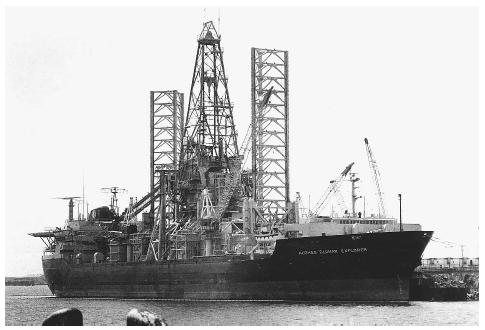Glomar Explorer
█ ADRIENNE WILMOTH LERNER
The Hughes Glomar Explorer was a salvage ship built for a clandestine Central Intelligence Agency mission to retrieve a sunken Soviet submarine. The United States government approached billionaire Howard Hughes in the late 1960s with a proposal to build the vessel under the guise of a business venture to mine manganese nodules off the ocean floor. The building of Glomar Explorer , or Hughes Mining Barge 1, and the submarine recovery effort were code named Project Jennifer.
On April 11, 1968, Naval Intelligence at Pearl Harbor intercepted distress messages from a Soviet submarine. The submarine, located in waters approximately 750 miles northwest of Hawaii, reported an onboard explosion while near the surface and then quickly sank. Hoping to find the wreckage of the submarine and recover the ballistic missiles on board, the Soviet fleet launched a search party. After two months of searching, the Soviets failed to locate their downed ship.
The Golf-class diesel submarine was one of the older vessels in the Soviet fleet, but nonetheless, the prospect of retrieving Soviet technology, nuclear weapons, and codebooks was enticing to American intelligence agencies. Because it could not send marked American Naval vessels to recover the sunken submarine without arousing suspicion from the Soviets, Naval intelligence enlisted the help of billionaire Howard Hughes to construct the specialized equipment and ship necessary for the salvage project. The six-year venture to build the ship and raise the Soviet submarine operated under the guise of a deep-sea mining operation.
Recovery efforts began on June 20, 1974. The 63,000-ton Glomar Explorer located the wreckage on the seabed at a depth of 17,000 feet (5,200 m) and scouted the downed vessel. Glomar Explorer had been fitted with a giant claw mechanism, nicknamed Clementine. A series of tethers stabilized the claw during underwater maneuvers. As the salvage effort began, the Glomar Explorer crew lowered Clementine to the wreck site. When the claw was nearly into position, an operator error at the controls sent the

claw careening into the sea floor. The salvage effort continued, however, and the claw was positioned around the ship. When the wreckage of the Soviet submarine was about a mile (1.6 k) from the water's surface, three of the mechanical claw's tine malfunctioned, apparently damaged in the crash into the ocean floor. Unable to sustain its own weight, the wrecked Soviet submarine tore apart. The crew aboard Glomar Explorer tensely waited for the broken part of the wreckage to hit the sea floor, fearing detonation of weapons on board the submarine.
While the crew of Glomar Explorer remained safe, the salvage effort suffered a substantial loss. Only the forward section of the ship was ultimately recovered. The CIA recovered Soviet communications apparatus, a few ballistic missiles, and various codebooks. A majority of the desired items and information, including most of the nuclear weapons and the Soviet crypto keys, remained on the sea floor in the wreckage.
The remains of six Soviet sailors were found in the recovered section of the submarine. The crew of the Glomar Explorer gave the sailors a ceremonial burial at sea, conducted in Russian.
In 1975, reporters from the Los Angeles Times broke the story of the Glomar Explorer . In the following months, various articles linked the Glomar Explorer , and its cover as deep-sea mining operation, to the CIA and the submarine salvage effort. After reporters appealed to the government for information on Project Jennifer, CIA officials refused to acknowledge the existence of any records pertaining to the operation. Since then, the terms "Glomar response" and "Glomarization" have been applied to situations when the existence of government documents is neither confirmed nor denied. Most of the records concerning Project Jennifer were declassified in 1995.
Although the submarine salvage effort did not meet expectations, and the Glomar Explorer was retired to dry dock for over fifteen years, the ship was completely over-hauled in 1996 and converted for use in commercial exploration and deep-sea drilling.
█ FURTHER READING:
BOOKS:
Burleson, Clyde W. The Jennifer Project. College Station: Texas A&M University Press, 1997.
Varner, Roy D. Matter of Risk: The Incredible Inside Story of the CIA's Hughes Glomar Explorer Mission to Raise a Russian Submarine. New York: Random House, 1979.
The Silent War by John Pina Craven
Red Star Rogue By Kenneth Sewell